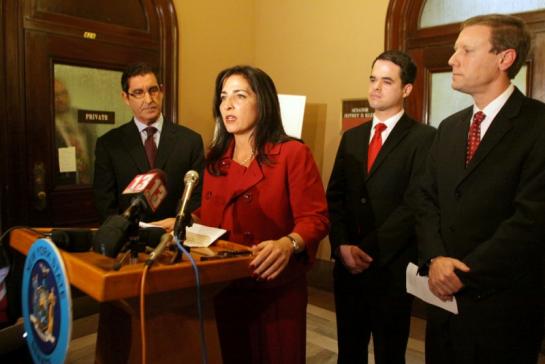Shifting Senate
Out of the sixty-three elections for the New York State Senate held on November 6th, two results have yet to be announced as ballots continue to be counted. The Democrats had control of one more Senate seat than the Republicans after results from sixty-one elections were finalized.
Despite the fact that the Democrats are almost assured to win one of the two remaining Senate seats, their majority is far from inevitable. Two years ago, the four-member Independent Democratic Conference (IDC) formed, and for whom they will cast their votes for Senate Majority Leader is yet to be determined. IDC leader Senator Jeffrey Klein (D-Bronx) has met with the current leadership of both parties concerning the IDC votes for Senate Majority Leader, but has only stated publicly that recognition of the IDC as a conference equal in status to the Republican Conference and Democratic Conference is a must.
Also complicating the Democrat’s hope to take the majority from the Republicans was Democratic Senator-elect Simcha Felder’s announcement that he will support the Republican Conference’s bid to retain the majority.
The Democratic State Senators should learn from their mistakes in 2010, when the leadership fight resulted in the Republicans retaking control of the Senate. The IDC has publicly announced policies are very similar with that of the Democratic conference. The IDC agrees with the Democrats on an overwhelming percentage portion of its policy, but has additional “common sense solutions to break the hyper-partisan gridlock in the New York State Senate.”
The differences between the Democrats and the IDC do not seem too significant to be debated internally within the Democratic caucus. IDC leader Klein should have instead opted to use his position as a former Democratic Senatorial Campaign Committee (DSCC) Chair and Deputy Leader to sway the opinion of his caucus members to support his positions. Instead, Klein abandoned the caucus with three other Democrats.
If the IDC is purely interested in Democratic initiatives, which, in addition to the “common sense solutions,” comprise the IDC platform, they should return to the Democratic Conference and vote against Republican Dean Skelos for Majority Leader. After all, if the IDC caucuses with the Republicans, that agenda is sure to be ignored.
Some Democratic Senators might be wary of the fact that the Senate has been in the control of the Republicans for decades, with the exception of a brief period in 2010. These Senators might estimate that the safest path to chairing a committee (which brings with it both increased legislative power and a pay raise) would be joining the IDC and caucusing with the Republicans. This accounts for the most significant critique of the IDC, that the four senators’ departure from the Democratic caucus was a political, not ideological, move.
The New York Daily News offers a strong rebuttal to this line of logic, citing Democratic registration advantages in forty-nine of the sixty-three newly drawn Senate districts. Between the registration advantage and a repeat performance of the well-executed DSCC campaign chaired by Senator Michael Gianaris (D-Queens), the Democrats are poised to continue trends of the last few elections and pick up more seats in 2014. In addition, Governor Cuomo’s reelection campaign will draw many independent voters, with whom Cuomo is exceptionally popular, to vote down the Democratic line.
The voters of New York expressed their support of the Democratic agenda on November 6th by supporting President Obama by over 62.5% of the vote, re-electing a Democrat-dominated State Assembly, and sending more Democrats than Republicans to the State Senate (assuming the Democratic candidate wins in one of the remaining two seats left to be determined). The members of the IDC should listen to the demonstrated will of their constituents and honor the Democratic majority in the Senate.

